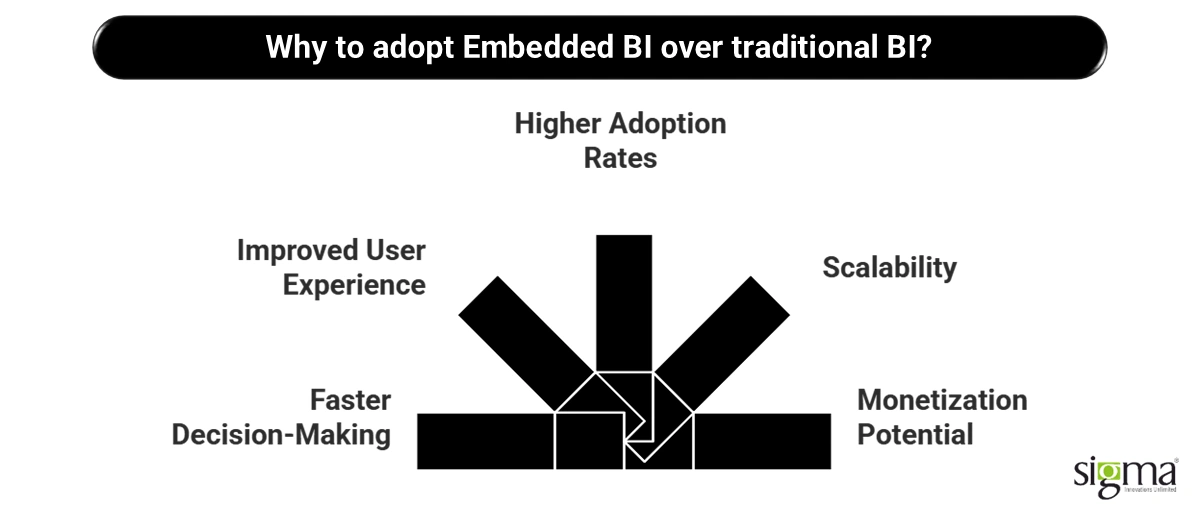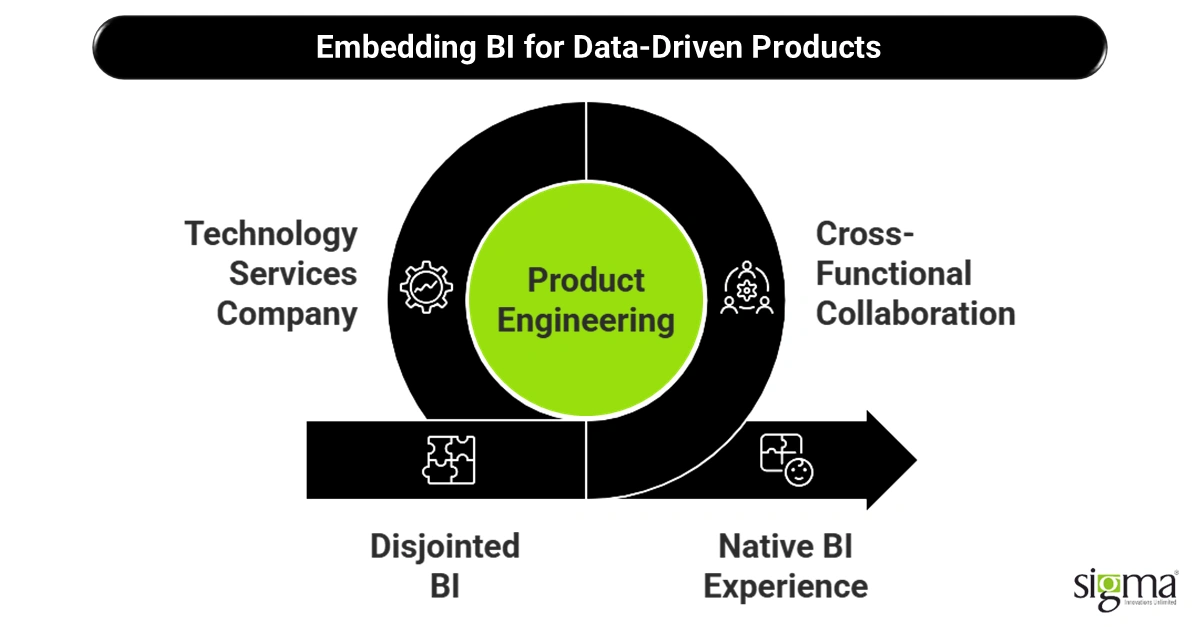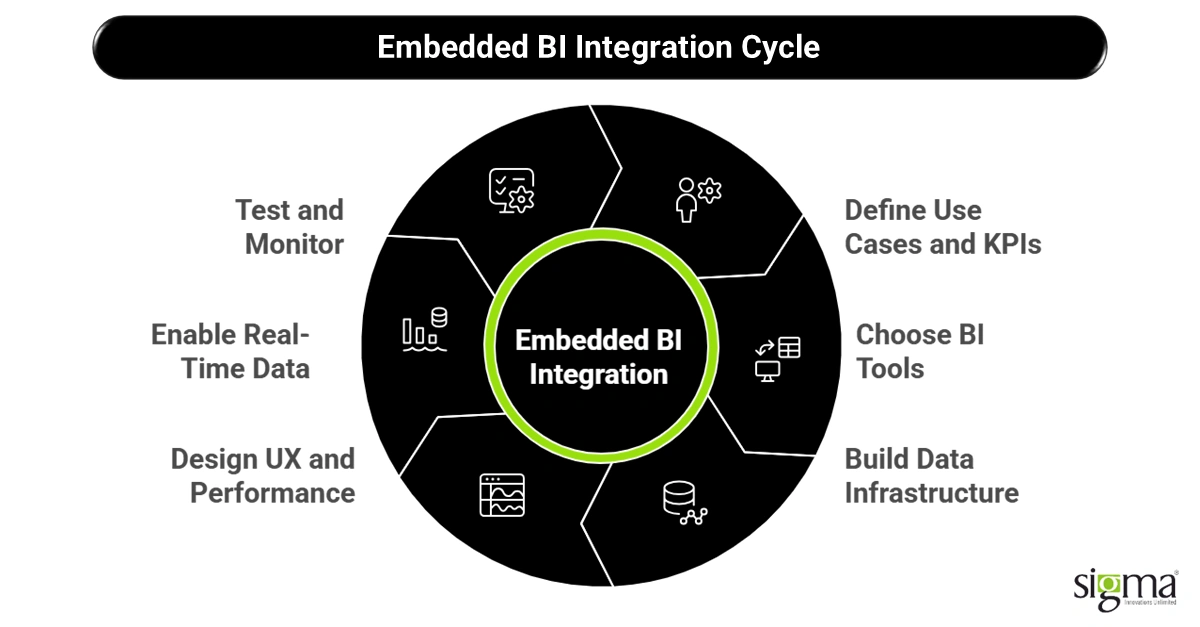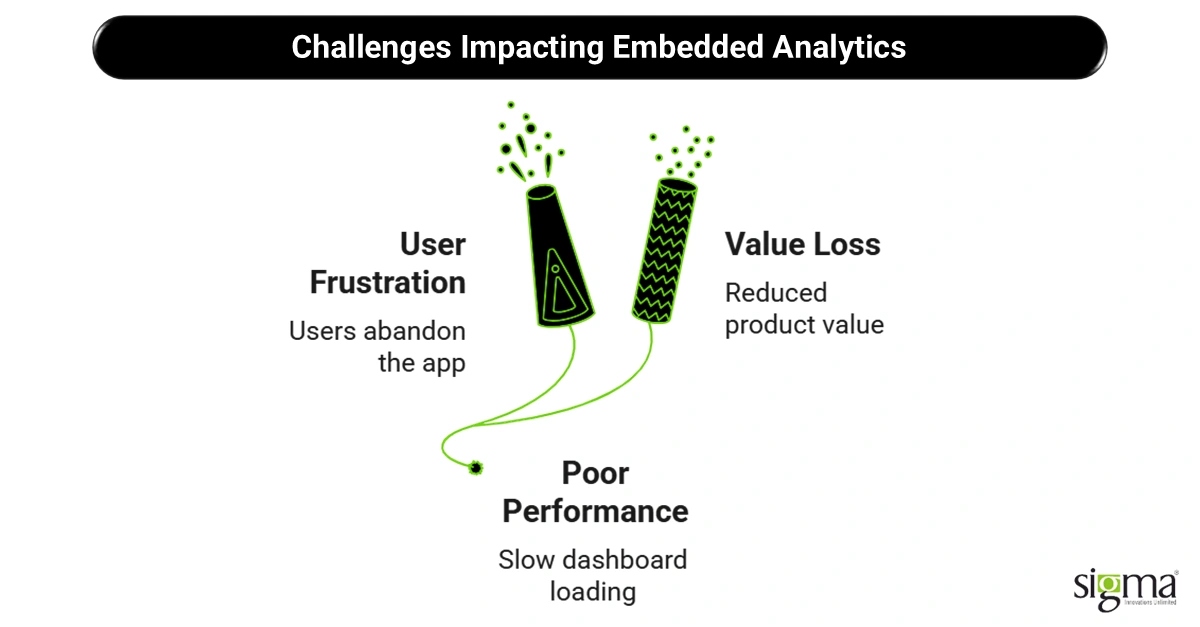Embedded Business Intelligence Solutions That Power Data-Driven Products

Users expect every product to be “smart,” offering real-time insights instantly. Whether it’s a financial dashboard, a retail analytics tool, or a logistics app, Embedded Business Intelligence (BI) makes this a reality.
Embedded BI Solutions refer to the seamless integration of dashboards, reports, and data visualizations directly into web and mobile applications. Instead of switching between platforms or digging through spreadsheets, users can analyze data right where they work. It’s like having a GPS built into your car, instead of needing to check your phone every few minutes.
For B2B companies building tech products, adding Business Intelligence Solutions isn’t just a nice-to-have anymore—it’s essential. Whether you’re helping businesses track performance, visualize financial data, or predict customer behavior, embedding analytics can set your product apart in a crowded market.
And none of this magic happens without strong product engineering. A solid engineering team bridges the gap between raw data and user-friendly insights, weaving BI directly into the user experience. From architecture to UI, product engineering is what makes Embedded BI not just functional—but frictionless.
What Is Embedded BI & Why It Matters Today
Let’s face it—traditional Business Intelligence services & solutions were built for analysts and C-suite dashboards. They required users to leave the app, log into a separate BI tool, and make sense of static reports. That’s like asking your GPS to email you turn-by-turn directions. It works… just not fast enough for today’s pace.
Embedded BI solutions flip this model on its head. Instead of sending users somewhere else to find answers, embedded BI brings those insights into the app or product they’re already using. Whether it’s a project management platform, a loan origination system, or a custom-built enterprise solution, users get real-time data insights without breaking their flow.
Here’s how Embedded BI outperforms traditional BI:

- Faster Decision-Making: No more switching tabs or exporting CSVs—users make decisions with live data, on the spot.
- Improved User Experience: Embedded dashboards and reports feel like a native part of the product—not bolted-on extras.
- Higher Adoption Rates: Teams actually use the insights because they’re accessible and relevant to daily workflows.
- Scalability: Businesses can serve hundreds or thousands of users with customized data views, all within the same app.
- Monetization Potential: Want to offer data as a premium feature? Embedded BI makes that easy to scale and secure.
In B2B products, this is a game-changer. When you empower your users—whether they’re business managers, sales leaders, or end customers—with real-time data insights for end-users, you turn your software into a strategic asset.
From supply chain analytics to customer behavior analytics for web stores, Embedded BI solutions ensure your application isn’t just operational—it’s intelligent.
And here’s the kicker: you don’t need to build an entire BI platform from scratch. With the right Business Intelligence services & solutions, you can engineer a seamless BI experience directly into your product—with speed, scalability, and precision.
Where Embedded BI Is Making the Most Impact
Embedded analytics isn’t a one-size-fits-all feature—it’s a powerful capability that adapts across industries. From SaaS and eCommerce to Fintech and Manufacturing, companies are using embedded BI solutions to deliver smarter products, faster decisions, and better user engagement.

Here’s a look at where embedded BI is driving real impact:
SaaS Platforms: Customer Analytics & Engagement
Modern SaaS products are more than tools—they’re platforms that help users make smarter choices every day.
With embedded analytics in SaaS applications, you can:
- Show users how they’re performing in real time
- Track usage trends and behavior directly in the app
- Offer real-time data insights for end-users without leaving your platform
This leads to higher stickiness, improved retention, and deeper engagement.
eCommerce: Customer Behavior Analytics for Web Stores
eCommerce platforms thrive on understanding buyer behavior. With customer behavior analytics, merchants gain:
- Live dashboards for cart abandonment, product performance, and sales conversion
- AI-driven insights into buying trends
- Personalized recommendations powered by real-time data
No more gut decisions—just smart selling based on data that’s always current.
Fintech: Real-Time Financial Data Visualization
Whether it’s a budgeting app, trading platform, or lending dashboard, Fintech thrives on speed and clarity.
Embedded BI enables:
- Real-time financial data visualization for balance sheets, transaction history, and forecasting
- Built-in risk dashboards to monitor credit exposure, fraud alerts, or regulatory triggers
- Intuitive charts and heatmaps that replace static spreadsheets
These tools not only empower users but also build trust with transparency.
Manufacturing: Production Analytics in ERP Platforms
In manufacturing, time is money—and insight is everything. Embedded BI in ERP systems allows:
- Real-time production analytics for downtime, output, and capacity
- Performance KPIs across multiple plants or assembly lines
- Predictive maintenance indicators for machinery.
It’s like turning your factory floor into a command center with digital oversight.
Across all these industries, embedded BI solutions turn raw data into real-time, user-facing insight. The result? Smarter software, happier users, and a serious competitive edge.
Foundations of Product Engineering for Embedded BI
Behind every seamless Embedded BI solution, there’s a solid foundation built on strong Product Engineering practices. But what exactly is Software Product Engineering, and why does it matter so much when embedding intelligence into apps?
What is Software Product Engineering?
Software Product Engineering Services go far beyond traditional IT services or one-off project deliveries. Instead of just “building to spec,” they focus on building end-to-end, scalable, and user-focused products.
Think of it like this: traditional IT builds the car. Product engineering builds the Tesla—with auto-updates, user data integration, and constant performance monitoring. Industry leaders like have all embraced this product-first mindset. It’s a shift from:
“Delivering software” → to → “Creating intelligent, evolving digital products.”

The Shift Toward Product-Oriented Thinking
Today’s users don’t just want software—they want features that evolve, dashboards that respond in real time, and experiences that feel intuitive. This shift means engineering teams now need to:
- Focus on long-term product scalability
- Design for continuous improvement and user feedback
- Build infrastructure that supports real-time BI components from the start
When building Embedded BI solutions, it’s not enough to tack on analytics at the end. The ability to deliver real-time data insights for end-users must be baked into the product from day one—and that’s where true Product Engineering plays a game-changing role.
The Power of Cross-Functional Collaboration
Embedding business intelligence isn’t just a coding job—it’s a team sport. Successful product engineering for data-driven apps involves close collaboration between:
- Data Engineers: Who prepare and manage the underlying data pipelines
- Front-End Developers: Who craft smooth UI experiences for embedded dashboards
- Product Managers: Who define analytics use cases aligned with end-user needs
- BI Architects: Who ensure data structures and KPIs are aligned with business goals
Without this synergy, embedded BI becomes clunky or disjointed. With it, the experience feels native and valuable.
Why Work with a Technology Services Company?
Building an intelligent product in-house sounds great—until you hit bandwidth, skill, or time limitations. This is where working with an experienced Technology Services company (like ours) can unlock huge benefits:
- Accelerated Time to Market: We’ve done this before—many times—so you avoid costly trial and error.
- Access to Specialists: From BI experts to cloud architects, you get cross-domain skills under one roof.
- Custom Solutions, Not Just Tools: We tailor BI functionality to your product’s architecture, not the other way around.
- Scalable Architecture: We help ensure your solution is ready for growth—across users, data, and markets.
Our team combines years of experience in Software Product Engineering Services, embedded BI tools, and enterprise-grade Technology Development Services. We help you move from idea to execution, creating data-driven products that scale—and sell.
Also Read: Is Embedded Analytics Ushering a New Wave in Healthcare?
How to Embed BI into SaaS/Web/Mobile Products: A Step-by-Step Guide
Building Embedded BI solutions is not just about slapping on some charts. It’s about crafting a cohesive, user-centric experience that delivers real-time insights and drives business outcomes. Whether you’re building a SaaS platform, mobile app, or enterprise tool, here’s your step-by-step blueprint to successfully embed BI into digital products.

Step 1: Define Use Cases and KPIs
Before you touch any code or BI platform, start by getting clear on why you need Business Intelligence integration. Every product is different—so your embedded BI goals should tie directly to your business goals.
Ask:
- What do our users need to know in real time?
- Which decisions are we trying to accelerate?
- What’s the ROI of showing this data?
Example Use Cases:
- Increase retention via customer churn prediction dashboards
- Improve onboarding with usage heatmaps and onboarding flow completion data
- Help merchants track top-selling products with live sales analytics
Remember: Data for the sake of data is noise. Data that helps your users win? That’s value.
Step 2: Choose the Right BI Tools
There’s no shortage of tools to help with Business Intelligence integration, but your choice depends on your product’s complexity, customization needs, and team skillset.
Popular Embedded BI Platforms:
- Looker: Great for data modeling + user permissions
- Tableau Embedded: Known for interactive visuals
- Power BI Embedded: Ideal if you’re in the Microsoft ecosystem
Build vs. Buy?
- Third-party integrations = faster to implement, limited flexibility
- Custom BI dashboards = tailored UX and data logic, higher upfront effort
Your Product Engineering for Data-Driven Apps strategy should balance speed, scalability, and flexibility.
Step 3: Build a Scalable Data Infrastructure
You can’t run real-time insights on spaghetti data. You’ll need a robust backend that moves data quickly, safely, and cleanly.
Core components:
- ETL Pipelines: Extract, transform, load—turn raw data into clean, structured gold
- Cloud Data Warehouses: BigQuery, Snowflake, Redshift—designed to handle high-speed analytics
- Data Governance: Define who can see what, avoid security gaps, ensure compliance (HIPAA, SOC2, GDPR, etc.)
Tip: If data security isn’t baked in from day one, you’ll regret it by day 100.
Step 4: Design for UX and Performance
No matter how powerful your backend is, a clunky interface will ruin the experience. UX matters a lot in Embedded BI.
Best practices:
- Build responsive dashboards for both web and mobile users
- Use interactive charts with drill-downs, filters, and tooltips
- Personalize based on roles (e.g., manager sees team-wide data, rep sees personal metrics)
- Keep load times low and visual clutter lower
Think of your dashboard as part of your product—not an add-on.
Step 5: Enable Real-Time Data Streams
Your users expect real-time insights, not yesterday’s news. To deliver that, you’ll need modern data streaming tools.
Popular tech options:
- Kafka: Distributed streaming at scale
- Apache Flink: Real-time event processing
- Custom Event Tracking: Push key interactions from your app directly into your BI layer
Use Cases:
- Live customer behavior tracking
- Real-time transaction monitoring in fintech apps
- Instant alerts on business-critical KPIs
Step 6: Testing, Monitoring, and Feedback Loops
Your BI should evolve just like your product. Regular testing ensures insights stay relevant and usable.
Key practices:
- A/B Test your dashboards: What layout or metric drives better user actions?
- Track user behavior: Heatmaps, clickstreams, and usage frequency can show what’s working
- Feedback Loops: Collect in-app feedback to keep improving
A strong Product Engineering team doesn’t just build features—they refine them over time with real user feedback.
Final Tip:
You don’t have to go it alone. Partnering with a skilled Technology Development Services company experienced in Software Product Engineering Services helps you avoid missteps and build smarter, faster, and more scalable embedded BI systems.
Challenges in Embedding BI – And How to Overcome Them
Embedding BI into your product sounds great on paper—but let’s be real. The road isn’t always smooth. From performance lags to user pushback and compliance headaches, there are real-world hurdles you’ll likely hit along the way.
Here’s a look at the most common challenges teams face when integrating Embedded Analytics—and how smart Product Engineering and a strong Enterprise Business Intelligence Solution can help overcome them.

1. Poor Performance in Embedded Dashboards
Let’s say you’ve built a sleek dashboard into your app, but it takes forever to load. Users get frustrated. They bounce. You lose value.
Why it happens:
- Heavy queries or poorly optimized data models
- No caching or data pre-processing
- UI components overloaded with too much logic
How to fix it:
- Implement caching layers or in-memory data processing to reduce load times
- Use lazy loading for widgets and reports
- Choose BI tools that support high performance with large datasets
- Optimize queries in your Enterprise Business Intelligence Solution for speed
Pro Tip: Consider solutions like Redis or Materialized Views for caching frequently accessed data.
2. Lack of User Adoption
You’ve built the dashboards. They look great. But… no one’s using them. Ouch.
Why it happens:
- Data visualizations don’t align with user needs
- Dashboards are too complex or not intuitive
- Users aren’t trained or aware of the feature
How to fix it:
- Design dashboards with your user personas in mind (keep it role-specific)
- Simplify the UX with clean layouts and interactive filters
- Run onboarding walkthroughs or offer tooltips and tutorials
- Track usage metrics to understand behavior and improve iteratively
If your Embedded Analytics isn’t delivering real-time data insights that users care about, it won’t stick—no matter how powerful the backend is.
3. Security and Data Privacy Issues
When embedding BI into products, you’re dealing with sensitive data—often financial, customer, or operational in nature. One misstep here can cost big.
Why it happens:
- Weak role-based access control
- No data encryption at rest or in transit
- Inadequate audit logging or compliance workflows
How to fix it:
- Use role-based access controls (RBAC) so users see only what they’re allowed to
- Encrypt sensitive data end-to-end
- Implement logging for all dashboard interactions for traceability
- Follow compliance standards like SOC2, HIPAA, or GDPR—depending on your industry
Data privacy isn’t just an engineering concern—it’s a product trust issue. Get it right from day one.
Wrapping It Up
Sure, embedding BI comes with its challenges—but they’re all solvable with the right planning and a capable tech partner. The key is to build a BI layer that’s not just embedded—but also efficient, intuitive, and secure.
Working with an expert Technology Development Services company gives you the frameworks, engineering support, and scalability to navigate these challenges and build a truly impactful Enterprise Business Intelligence Solution.
Sigma Infosolutions POV: Product Engineering for Embedded BI
At Sigma Infosolutions, we don’t just write code—we engineer intelligent products that empower users and fuel business growth. Our Software Product Engineering Services are built with a strong foundation in Business Intelligence Services & Solutions, allowing us to embed smart analytics directly into SaaS platforms, eCommerce portals, and fintech products with speed and precision.
Whether you’re launching a new data product or upgrading an existing system, our team brings deep experience in Embedded Analytics in Products, coupled with the latest technologies in BI platforms, data architecture, and cloud scalability.
How We Help Embed BI Into Digital Products
- SaaS Dashboards: We help SaaS companies deliver real-time KPIs and user-specific metrics through tailored BI dashboards that drive engagement and stickiness.
- eCommerce Analytics: Our product engineers design analytics modules that track buyer behavior, product trends, and inventory flows—right inside your web store.
- Fintech Visualization Tools: From lending platforms to budgeting apps, we integrate real-time data insights like transaction histories, credit scoring models, and risk heatmaps seamlessly into user workflows.
Why Clients Choose Us
- Faster Time-to-Market: Our proven engineering playbooks and BI accelerators shorten your product development lifecycle—so you get insights in front of users, faster.
- Custom UX/UI for Analytics: We go beyond plug-and-play, designing interfaces that feel native, are fully responsive, and elevate the user experience.
- Scalable & Secure BI Integrations: Built for growth, our embedded BI solutions are secure, compliant, and architected to scale with your user base and data volume.
Want to see it in action? Discover how our Software Product Engineering Services led to significant improvements in ticket resolution with AI in our Automating Ticket Resolution with AI-Powered Resolvify++ case study.
Future Trends in Embedded BI & Product Engineering
The world of Embedded BI Solutions is evolving fast—and so is the role of Product Engineering in making it all happen. As businesses race to deliver smarter, faster, and more personalized data experiences, a few key trends are shaping the future of embedded analytics.
AI-Powered Dashboards & Predictive Analytics
We’re moving from “what happened?” to “what will happen?” With AI and machine learning, embedded BI tools are now generating predictive dashboards that spot trends, flag anomalies, and even suggest next steps—all within the product.
Imagine a lending platform that not only shows loan performance but also forecasts delinquencies. That’s where real-time insights meet proactive decision-making.
Natural Language Query Interfaces
“Chat with your data” is no longer sci-fi. Natural language processing (NLP) is making BI more conversational. Users can ask, “What were our top-selling categories last quarter?” and get instant, visual answers.
This reduces reliance on analysts and turns every team member into a data-savvy decision-maker.
Self-Service Analytics for End-Users
The future belongs to users who don’t want to wait on dev teams for reports. Self-service dashboards with drag-and-drop features, filters, and drill-downs empower users to explore their data on their own—directly within the app.
Rise of Product-Minded Engineers
As BI becomes core to product strategy, engineering teams must think like product managers. Future-ready teams are blending development skills with customer empathy to build data tools that are fast, helpful, and delightful to use.
The magic behind intelligent, scalable, and user-first products, all fueled by data, lies in Product Engineering. This crucial discipline isn’t just about creation; it’s also vital for enhancing an enterprise’s digital resilience and enabling product-led growth.
Building the Next Generation of Data-Driven Products
In today’s digital landscape, embedding Business Intelligence isn’t just a feature—it’s a product differentiator. From SaaS platforms to fintech dashboards and eCommerce analytics, users now expect data to be accessible, interactive, and actionable within the product itself. This shift demands more than just integration—it calls for strong, scalable Software Product Engineering Services that align BI capabilities with core product workflows.
As embedded analytics becomes mission-critical, organizations must evaluate whether their current architecture, UX strategy, and engineering practices are ready for this transformation. Those who act now will gain a powerful edge—turning real-time data into user delight and strategic insight.
Ready to build smarter, data-driven products?
Explore Sigma Infosolutions’ Product Engineering Services for Embedded BI.